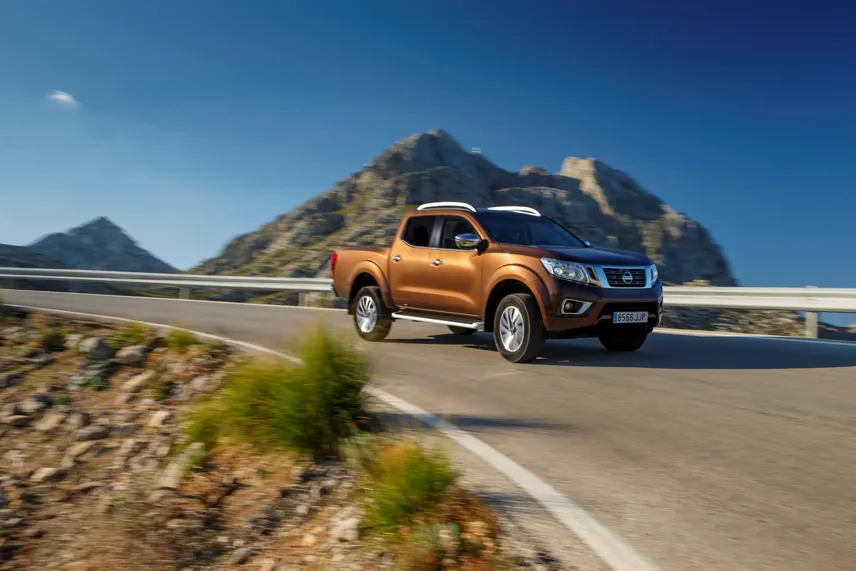Review
If there is one area of the LCV market that has come on in leaps and bounds in the past 15 years, it must be the four-wheel drive truck segment.
Until the arrival of the Nissan Navara back in 2005, all offerings were agricultural in the extreme – agile enough in the rough but so bone-shaking on the roads as to be unpleasant to drive for any distance.
The Navara was the first off-roader to have acceptable road manners. But, since then of course, many other newer contenders have gone on sale, offering smoother ride, better fuel economy and newer technology. The current model has been left in the slow lane when it comes to wholelife costs.
The new incarnation that is due to go on sale in January redresses the balance in no uncertain terms, offering best-in-class fuel economy, CO2 emissions, payloads, towing capacity and load area.
The slogan for the new Navara, which now has the moniker NP300 tacked on the front, is ‘tough as always, smarter than ever’. At the launch in Majorca, Jamie Maclean, Nissan’s European truck planning manager, explained that the designers had gone right back to square one with the new contender, asking the question: “What is a pick-up truck?”
He told Commercial Fleet: “This may sound like a basic question but we believe it is one that none of the other manufacturers are asking. They keep building the same thing over and over again, but we are different.”
Maclean said there were four basic requirements for a pick-up. First, it had to be a commercial vehicle, capable of earning a living. Second, it had to be a tough off-roader. Third, it must look smart, as it represented a business when out on the road and, fourth, it must be capable of doubling up as a recreational vehicle.
“With most other 4x4 trucks you have to compromise in these areas but with modern technology you should not have to compromise and we believe we have made the ultimate go anywhere vehicle,” he said.
The new Navara is new from the nuts and bolts upwards. The outer shell is stylish and upmarket while still maintaining that macho appeal that old model always had.
The old 2.5-litre Nissan diesel powerplant has been replaced by Renault’s tried and trusted 2.3-litre dCi unit and there are two power outputs, 160bhp and 190bhp, while torque is a meaty 295lb-ft and 332lb-ft, ensuring plenty of lowdown grunt when the vehicle gets in the rough.
Both six-speed manual and seven-speed auto gearboxes are on offer.
Fuel economy is up to 24% better than the old models – which translates to a saving of £1,300 over three years/60,000 miles. Towing capacity is 3,500kg.
While single-cab versions won’t be available, Nissan is offering king-cabs and double-cabs, with the double-cab expected to take 90% of sales. There’s a king-cab two-wheel drive version on offer at £18,376, ex-VAT, and a total of five spec levels will be available, Visia, Acenta, Acenta+, N-Connecta and Tekna, each adding extra spec on the way up, with prices topping out at £24,293. There are no fewer than 120 accessories available, including hard tops, sliding rear trays and racks.
And let’s not forget that all Navaras have a five-year/100,000 mile warranty, which can be passed on to second users.
The other big news is that all double-cabs now feature five-link rear coil suspension systems – a first in the sector as all the other contenders use the more old-fashioned leaf spring systems. This set-up gives much improved ride and handling, especially when the vehicles are empty – but note that the king-cabs still feature the old leaf springs.
In the cab, the dash is all new and is now a mass of classy blacks, whites and silvers, while the seats are noticeably more supportive and comfortable than those in the old model. According to Maclean, the seat supports are based on research that NASA undertook when building these items for its spacecraft, removing pressure points and keeping the whole body in place.
There are plenty of grab rails, for when the going gets tough, and a few nice touches such as a 12-volt take-off on top of the dash, so that plug-in sat-nav leads aren’t left trailing all over the place, and a sunglasses holder in the roof.
We tested both double-cab and king-cab versions, the first with the 190hp engine and a seven-speed auto gearbox and the smaller contender with the 160hp variant mated to a six-speed manual box.
The two rear seats in the king-cab are pretty squashed up ‘dickies’ which can fold up to allow for more storage space when not needed. Passengers certainly wouldn’t want to travel far in them, as there is a severe shortage of legroom. By comparison, there is a fair amount of space for three passengers in the double-cab and our test model featured leather seats.
We weren’t too impressed with the gear lever in the king-cab, which had a rather old-fashioned long throw and was none too precise. But ride and handling were taut enough and on our test route, amid the steep slopes in the north of Majorca, the Navara proved a diamond.
Swapping over to the double-cab, we found the 190hp engine much more refined, with a very quiet cab. The different suspension unit certainly gave this variant a better feel both on and off-road.
On a special off-road course, nothing we could throw at the truck worried it in the slightest. The Navara features both hill descent control and hill start assist, so with the autobox in drive and setting the dial on the dashboard in ‘4wd low’, even novice drivers will be guided through the toughest of courses without having to give any input whatsoever, apart from turning the steering wheel.
















